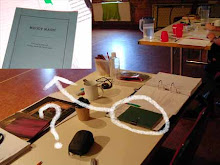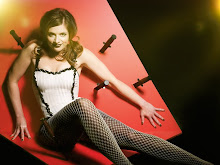
There have been quite a few small script changes over the last few days, and some minor changes in scene order. They talk through the play scene by scene, moment by moment to clarify that everybody has the same script, the same order of scenes, and a similar understanding of the journey of the play as a whole.
The discussion is focused, but engages a few different fronts, so it takes most of the day. There is a good amount of old fashioned script analysis; what does every scene do in the play, why characters say what they say when they say it. They discuss what each line and action means across the entire journey of the play. The process is long and there are occasional references to time running short, but everybody is digging in really hard.
I take the opportunity to go down and talk to wardrobe. Amanda and Kate are doing the costume build. The wardrobe section is in not in the main Malthouse building, which is probably why we haven't been down there before. Liz, seconded from VCA, takes me down there. It's kind of exciting to head down there; today's video is entitled, “My Wardrobe Odyssey.” Check it out.
Wardrobe is a really fabulous place. A large window to the left fills the room with natural light; sometimes a scarce commodity in theatre buildings. There are cool looking pieces of clothes-
 making equipment everywhere, those huge industrial strength fabric scissors, wigs, crazy hats, reams of material of all kinds. Jonathon is pulling a piece of ribbon out of somewhere and is asking if he can have it. And Bob Marley is playing! Amanda tells me she likes it here because they are removed from the stress that often inhabits the main theatre building. With openings and previews and closings and artists under pressure and issues of all kinds, theatre buildings house huge amounts of energy. It's what makes theatres such wonderful places, but this place does feel like a bit of a refuge.
making equipment everywhere, those huge industrial strength fabric scissors, wigs, crazy hats, reams of material of all kinds. Jonathon is pulling a piece of ribbon out of somewhere and is asking if he can have it. And Bob Marley is playing! Amanda tells me she likes it here because they are removed from the stress that often inhabits the main theatre building. With openings and previews and closings and artists under pressure and issues of all kinds, theatre buildings house huge amounts of energy. It's what makes theatres such wonderful places, but this place does feel like a bit of a refuge.There is a cape on the main work table, with all kinds of features being attached. It's detailed work. I ask Kate how long it will take to make; 2 days is the reply. What's more, she says, she has to make two of them.
Amanda is sewing up a corset off to the right. For somebody like me, who mostly wears clothes that have been mass made in China, it's actually pretty wonderful to see somebody sewing up a corset from scratch. Immediately, the question enters my mind of how much time all these costumes take to make. I notice that the trim on the corset is being ironed on. Nevertheless, it's a massive undertaking.

I ask them if they are on schedule. They say they are, but the appearance of the countdown on the blog was a bit frightening nonetheless. When I ask them if I could see the costumes they've made to date they point to a couple of big plastic bags full of pieces; turns out they don't completely sew things up until later on.
They tell me the build takes 2 people all of the 4 week rehearsal period to make the costumes. They generally work from about 7.30 until 6 in the evening. No doubt, there will be a lot of work to do once the show gets into production week and the actors are wearing them for the first time with performance energy.

Even though they wouldn't let me take any video, they would let me take a few snaps of a corner of the room. Maybe next time I'll be able to film their workshop for you. Tomorrow is the last day of the third week. Lawrence Leung is in the house, and I'll also be talking to Malthouse AD Michael Kantor. So don't miss tomorrow's blog. It's starting to feel close now!
PLUS – the 'Chair of Unhappy' arrives from the workshop. Now that is going to be something!





